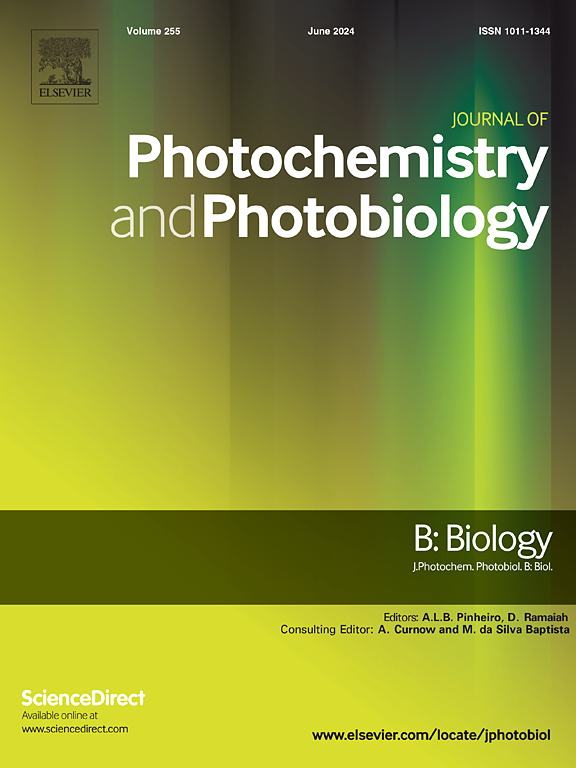Role of UVA-driven cellular senescence via mTOR activation in dihydrotestosterone-induced hair loss in androgenetic alopecia mouse model
IF 3.9
2区 生物学
Q2 BIOCHEMISTRY & MOLECULAR BIOLOGY
Journal of photochemistry and photobiology. B, Biology
Pub Date : 2025-06-18
DOI:10.1016/j.jphotobiol.2025.113200
引用次数: 0
Abstract
Background
Androgenetic alopecia (AGA) is one of the most common forms of hair loss, and recent studies suggest that dihydrotestosterone (DHT)-induced senescence of dermal papilla cells (DPCs) plays a crucial role in its pathogenesis. Clinically, we previously observed an overlap between areas exposed to ultraviolet (UV) radiation and regions affected by androgenetic hair loss. However, the relationship between UVA radiation and AGA onset remains unclear. Therefore, we aimed to investigate the role of UVA in intensifying DHT-induced hair loss, with focus on potential activation of cellular senescence pathways.
Methods
We used an AGA mouse model combined with UVA irradiation to examine the role of UVA in delaying DHT-induced hair growth. To further investigate the mechanisms of the interaction between DHT and UVA, we isolated human dermal papilla cells and performed transcriptome sequencing analysis. Senescence-associated β-galactosidase (SA-β-Gal) staining, quantitative PCR, and western blotting were used to assess senescence and autophagy. Rapamycin was tested in vivo for its ability to mitigate hair loss.
Results
UVA accelerated DHT-Induced hair growth delay in AGA mouse model. UVA exposure intensified DHT-induced cellular senescence in hDPCs. This process was associated with the activation of mTOR pathway. However, rapamycin alleviated UVA- and DHT-induced cellular senescence by modulating autophagy dysfunction. Furthermore, rapamycin effectively reversed UVA-exacerbated DHT-induced hair loss in AGA mouse model.
Conclusion
UVA exposure can affect autophagy via the mTOR pathway, enhancing DHT-induced cellular senescence in DPCs. Rapamycin shows potential as a therapeutic agent to counteract these effects, offering a novel strategy for treating AGA.

uva驱动的细胞衰老通过mTOR激活在雄激素性脱发小鼠模型中双氢睾酮诱导的脱发中的作用
雄性激素性脱发(AGA)是最常见的脱发形式之一,最近的研究表明,双氢睾酮(DHT)诱导的真皮乳头细胞(DPCs)衰老在其发病机制中起着至关重要的作用。在临床上,我们之前观察到暴露于紫外线(UV)辐射的区域和受雄激素性脱发影响的区域之间存在重叠。然而,UVA辐射与AGA发病之间的关系尚不清楚。因此,我们旨在研究UVA在增强dht诱导的脱发中的作用,重点关注细胞衰老途径的潜在激活。方法采用AGA小鼠模型联合UVA照射,研究UVA对dht诱导的毛发生长的延缓作用。为了进一步研究DHT和UVA相互作用的机制,我们分离了人真皮乳头细胞并进行了转录组测序分析。衰老相关β-半乳糖苷酶(SA-β-Gal)染色、定量PCR和western blotting检测衰老和自噬情况。雷帕霉素在体内测试了其减轻脱发的能力。结果va加速dht诱导的AGA小鼠毛发生长延迟。UVA暴露加剧了dht诱导的hDPCs细胞衰老。这一过程与mTOR通路的激活有关。然而,雷帕霉素通过调节自噬功能障碍来减轻UVA和dht诱导的细胞衰老。此外,雷帕霉素有效逆转了uva加重dht诱导的AGA小鼠脱发模型。结论uva暴露可通过mTOR途径影响DPCs细胞自噬,增强dht诱导的DPCs细胞衰老。雷帕霉素显示了作为一种治疗药物抵消这些影响的潜力,为治疗AGA提供了一种新的策略。
本文章由计算机程序翻译,如有差异,请以英文原文为准。
求助全文
约1分钟内获得全文
求助全文
来源期刊
CiteScore
12.10
自引率
1.90%
发文量
161
审稿时长
37 days
期刊介绍:
The Journal of Photochemistry and Photobiology B: Biology provides a forum for the publication of papers relating to the various aspects of photobiology, as well as a means for communication in this multidisciplinary field.
The scope includes:
- Bioluminescence
- Chronobiology
- DNA repair
- Environmental photobiology
- Nanotechnology in photobiology
- Photocarcinogenesis
- Photochemistry of biomolecules
- Photodynamic therapy
- Photomedicine
- Photomorphogenesis
- Photomovement
- Photoreception
- Photosensitization
- Photosynthesis
- Phototechnology
- Spectroscopy of biological systems
- UV and visible radiation effects and vision.

 求助内容:
求助内容: 应助结果提醒方式:
应助结果提醒方式:


